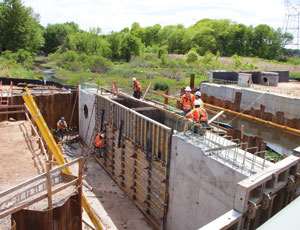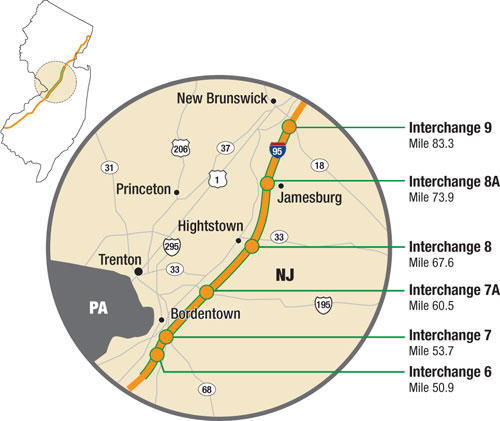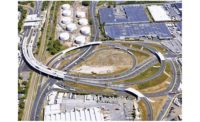The New jersey turnpike authority split its $2.3-billion Interchange 6 to 9 Widening Program into dozens of projects to help spread opportunities among design and construction firms during the economic downturn. In doing so, companies of all sizes secured work and the NJTA saved millions of dollars in its budget.

Now the NJTA and its build teams face the daunting task of keeping one the country’s largest road-building projects on track for a 2014 completion.
“The major challenge is how to manage a project of this magnitude,” says Larry Williams, assistant chief engineer for construction for the NJTA.
The program, which broke ground in 2009, aims to increase capacity along a 35-mile section in Central New Jersey by expanding the road to 12 lanes and modifying four interchanges for smoother traffic flow. The scope includes: building 60 bridges, modifying 36 other structures, adding 170 asphalt lane miles and creating 68 detention basins.
The turnpike authority divided the project into 31 contracts; 26 have been awarded to date. Contract values range from a couple of million dollars to $148 million. NJTA has also awarded three of the four advanced fabrication contracts for signage and two of four environmental mitigation contracts.
Beat The Budget
Given the timing, construction bids are trending about 20% below expectations, with at least 10 firms bidding on every contract. For instance, Contract 103, awarded to George Harms Construction Co., Howell, N.J., came in at $111 million, while the engineering estimate was for $150 million. John Keller, supervising engineer with NJTA, anticipates letting to bid two large construction contracts in 2011, one valued at about $50 million and the other at about $150 million.
“Knowing the economy was working with us, we really pushed things out in order to hit the lull in the economy,” he says.
Turnpike officials began purchasing 331 parcels for right of way—including 18 homes—based on preliminary engineering, rather than waiting until final documents were complete. The authority also moved forward with the relocation of 16 miles of 16-in.-dia petroleum and gas pipelines running adjacent to the road, with the utilities completing that work last year. Altogether, the authority issued 88 utility orders, including the three pipeline contracts that totaled $200 million.
“The most significant accomplishment to date has been the relocation of all of the petroleum pipelines,” says Thomas P. O’Connor, vice president of AECOM, Piscataway, N.J., and project manager for the AECOM/GPI/PB Joint Venture in East Windsor, N.J., that has served as the constructability and scheduling consultant and is providing construction management services on six of the sections. Partners include Greenman-Pedersen of Babylon, N.Y., and Parsons Brinckerhoff of New York.
HNTB, New York, serves as design program manager and is providing construction management for Section 6. Shaw Group, Trenton, N.J., serves as construction manager on Section 4.
Design innovation
The NJTA divided the project into eight sections to give more firms an opportunity to participate and to get the work out more quickly. Louis Berger Group, Morristown, N.J., completed the preliminary design and environmental documentation and recommended the division into sections. The company also designed Section 4.
“Overall, it was challenging because of the time frame the authority was under to move this forward,” says Robert Thiel, project manager for Louis Berger Group.
The turnpike authority determined design concepts early on so that structures would have a similar appearance along the length of the road, despite having been designed by eight different firms.
“One of our responsibilities was to produce design directives so [that] everyone was going in the same direction,” says Arthur A. Linfante Jr., project manager for HNTB. “We didn’t want this section to look different from the rest of the New Jersey Turnpike.”
While following similar design concepts, each firm had to address different challenges in their respective sections.
Section 1, designed by PB Americas, Princeton, N.J., includes Interchange 6, which connects Interstate 95 and Interstate 276 and is the most southern interchange. Flyover bridges with curved steel girders connect the inner and outer roadways of the turnpike with the other highways. Drilled shafts and spread-footing foundations support the bridges.
AECOM designed Section 2, which includes a new ramp configuration for Interchange 7 with large drilled shafts to support the new spans.
Michael Baker Jr. of Hamilton, N.J., designed the 3.5-mile Section 3, which includes northbound and southbound service areas and the four bridges to serve them.
|
TOP FIVE TURNPIKE CONSTRUCTION CONTRACTS The New Jersey Turnpike Authority divided the Interchange 6 to 9 Widening Program into 31 construction contracts, ranging from a few million dollars to $148 million. The top five contracts include: | |||||||||||||||||||||
| |||||||||||||||||||||
 |
“Having a dual roadway with inner and outer lanes [creates a situation where] getting people from the inner lanes to the service area requires flyover structures,” says Joseph Danyo, project manager with Michael Baker. “It takes off, climbs up and flies over the inner and outer roadway and comes down into the service area. They are pretty complex bridges.”
The bridges will use precast mechanical stabilized earth abutments, which are quick to assemble. They are also a new twist for the turnpike, which traditionally has used cast-in-place concrete abutments, Danyo says.
Section 4 includes connecting Interchange 7A with Interstate 195, the expansion of the toll plaza from 10 to 13 lanes, 2.5 miles of main lane widening and construction, and 13 replacement bridges, constructed in stages. The longest bridge is between 900 ft and 1,000 ft long. All of the bridges have steel girders with high-performance reinforced concrete decks to improve longevity, says Peter Burd, project manager for Shaw.
“The high-performance concrete is less permeable to water and salt intrusion, which accounts for most of the extension of the life cycle,” Burd adds. The mix includes fly ash as well as cement, sand and stone.
Article toolbar

Post a comment to this article
Report Abusive Comment